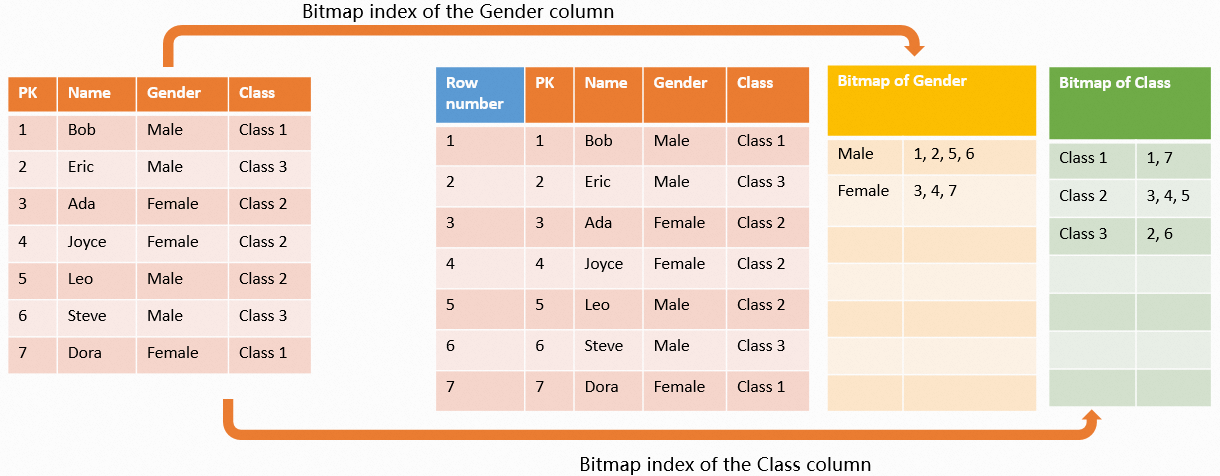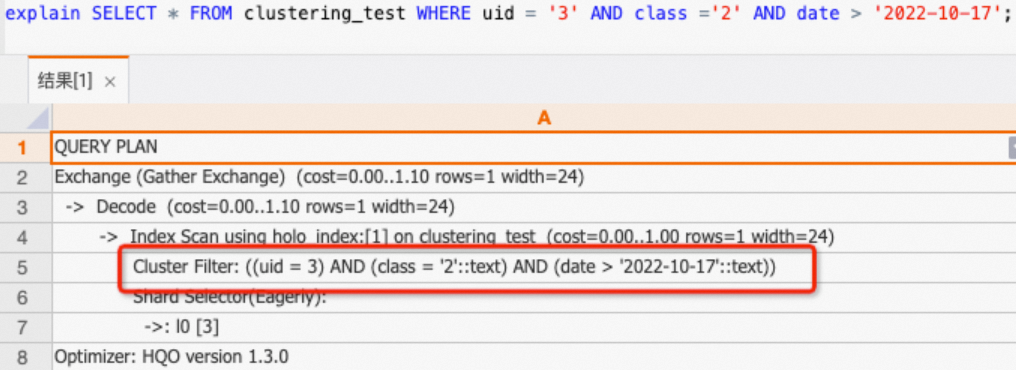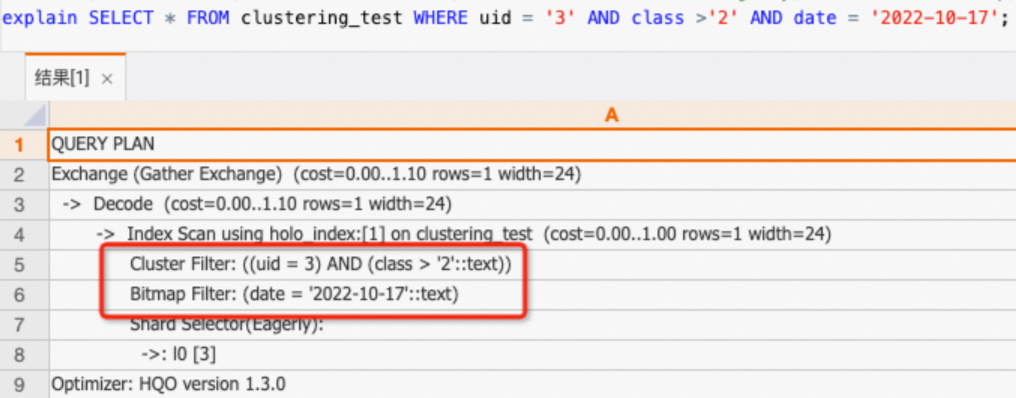This topic describes how to use bitmap indexes in Hologres.
Overview
In Hologres, the bitmap_columns property specifies a bitmap index. This property uses an index schema that is independent of data storage. You can use the bitmap_columns property to accelerate equivalent comparisons based on a bitmap vector structure. Bitmap indexes can help filter data that equals a specified value in a stored file. Therefore, the bitmap_columns property is applicable to point queries. The following syntax is used to set a bitmap index:
-- Syntax supported by Hologres V2.1 and later
CREATE TABLE <table_name> (...) WITH (bitmap_columns = '[<columnName>{:[on|off]}[,...]]');
-- Syntax supported by all Hologres versions
CREATE TABLE <table_name> (...);
CALL set_table_property('<table_name>', 'bitmap_columns', '[<columnName>{:[on|off]}[,...]]');Parameter | Description |
table_name | The name of the table. |
columnName | The name of the column. |
on | Indicates that a bitmap index is created for the current column. |
off | Indicates that no bitmap index is created for the current column. |
Usage notes
We recommend that you specify a bitmap index for an equivalent query column. This way, Hologres can quickly locate the number of the row where the data that meets the filter conditions resides. If you specify a bitmap index for columns with high cardinality, additional storage overheads occur. Columns with high cardinality indicate that the columns contain less duplicate data.
We recommend that you do not specify a bitmap index for each column in a table. This is because if you specify a bitmap index for each column in a table, additional storage overheads occur, and write performance is affected.
We recommend that you do not create bitmap indexes for columns whose JSON-formatted data is stored as the TEXT data type.
Limits
Only column-oriented tables and row-column hybrid tables support bitmap indexes. Row-oriented tables do not support bitmap indexes.
The columns specified by the bitmap_columns property can be null.
By default, all columns of the TEXT data type in a column-oriented table are specified as bitmap index columns.
You can execute the statement for modifying a bitmap index column outside of a transaction block. The modified column does not immediately take effect. Bitmap indexes are asynchronously built and deleted at the backend. For more information, see ALTER TABLE.
You can set
bitmap_columnsonly toonoroff. The valueautois invalid forbitmap_columnsin Hologres V2.0 and later.
How it works
Bitmap indexes are different from distribution keys and clustering keys and are independent of data storage. After you specify a bitmap index for a column, Hologres generates a binary string for the value in the column. A binary string corresponds to a value in the bitmap index column. If a query hits the bitmap index, Hologres quickly locates the number of the row where the data resides. However, the bitmap index still results in overheads. Take note of the following items:
If columns with high cardinality exist in a table, after you specify a bitmap index for a column, Hologres generates a binary string for the value in the column. If many distinct values are involved, a sparse array is generated and a large amount of storage resources are consumed.
If you specify a bitmap index for each column in a wide table, when data is written, Hologres generates a binary string for each value in the columns of the table. This causes system overheads, which affect write performance.
To sum up, bitmap indexes can be used to reduce the data query time at the cost of storage. Bitmap indexes are cost-effective for columns in which data is evenly distributed.
The following example shows how to use the EXPLAIN statement to check whether the query hits the bitmap index. If the execution plan contains the Bitmap Filter operator, the query hits the bitmap index.
Syntax supported by Hologres V2.1 and later:
CREATE TABLE bitmap_test ( uid int NOT NULL, name text NOT NULL, gender text NOT NULL, class text NOT NULL, PRIMARY KEY (uid) ) WITH ( bitmap_columns = 'gender,class' ); INSERT INTO bitmap_test VALUES (1,'Bob','Male','Class 1'), (2,'Eric','Male','Class 3'), (3,'Ada','Female','Class 2'), (4,'Joyce','Female','Class 2'), (5,'Leo','Male','Class 2'), (6,'Steve','Male','Class 3'), (7,'Dora','Female','Class 1'); explain SELECT * FROM bitmap_test where gender='Male' AND class='Class 1';Syntax supported by all Hologres versions:
begin; create table bitmap_test ( uid int not null, name text not null, gender text not null, class text not null, PRIMARY KEY (uid) ); call set_table_property('bitmap_test', 'bitmap_columns', 'gender,class'); commit; INSERT INTO bitmap_test VALUES (1,'Bob','Male','Class 1'), (2,'Eric','Male','Class 3'), (3,'Ada','Female','Class 2'), (4,'Joyce','Female','Class 2'), (5,'Leo','Male','Class 2'), (6,'Steve','Male','Class 3'), (7,'Dora','Female','Class 1'); explain SELECT * FROM bitmap_test where gender='Male' AND class='Class 1';
The execution plan contains the Bitmap Filter operator. This indicates that the query hits the bitmap index.
Differences between bitmap indexes and clustering keys
Similarity:
Bitmap indexes and clustering keys are used to filter data in files.
Differences:
Bitmap indexes are used to locate data by using file numbers. Therefore, bitmap indexes are more suitable for equivalent queries. Clustering keys are used to sort data in files. Therefore, clustering keys are more suitable for range queries.
Compared with bitmap indexes, clustering keys have a higher priority. If you specify the clustering key and the bitmap index for the same column, the query optimizer preferentially uses the clustering key to match the files. The following statements provide an example:
Syntax supported by Hologres V2.1 and later:
-- Specify the uid, class, and date columns as the clustering key and the text column as the bitmap index. CREATE TABLE ck_bit_test ( uid int NOT NULL, name text NOT NULL, class text NOT NULL, date text NOT NULL, PRIMARY KEY (uid) ) WITH ( clustering_key = 'uid,class,date', bitmap_columns = 'name,class,date' ); INSERT INTO ck_bit_test VALUES (1,'Bob','1','2022-10-19'), (2,'Eric,'3','2022-10-19'), (3,'Ada','2','2022-10-20'), (4,'Joyce','2','2022-10-20'), (5,'Leo,'2','2022-10-18'), (6,'Steve','3','2022-10-17'), (7,'Dora','3','2022-10-20');Syntax supported by all Hologres versions:
-- -- Specify the uid, class, and date columns as the clustering key and the text column as the bitmap index. begin; create table ck_bit_test ( uid int not null, name text not null, class text not null, date text not null, PRIMARY KEY (uid) ); call set_table_property('ck_bit_test', 'clustering_key', 'uid,class,date'); call set_table_property('ck_bit_test', 'bitmap_columns', 'name,class,date'); commit; INSERT INTO ck_bit_test VALUES (1,'Bob','1','2022-10-19'), (2,'Eric,'3','2022-10-19'), (3,'Ada','2','2022-10-20'), (4,'Joyce','2','2022-10-20'), (5,'Leo,'2','2022-10-18'), (6,'Steve','3','2022-10-17'), (7,'Dora','3','2022-10-20');
If you query the
uid, class, and datecolumns, the SQL query statement complies with the leftmost matching principle, and the query hits the clustering key. The clustering key instead of the bitmap index is used even in equivalent queries.SELECT * FROM clustering_test WHERE uid = '3' AND class ='2' AND date > '2022-10-17';The following figure shows that the execution plan contains the
Cluster Filteroperator instead of theBitmap Filteroperator. This indicates that the clustering key instead of the bitmap index is used in the query.
If you query the
uid, class, and datecolumns and the query of theclasscolumn is a range query, the leftmost matching principle does not work during the query after data in the range specified in the SQL statement is matched. In this case, the query of thedatecolumn cannot hit the clustering key because the query statement does not follow the leftmost matching principle. If you specify a bitmap index for thedatecolumn, the bitmap index is used in the query.SELECT * FROM clustering_test WHERE uid = '3' AND class >'2' AND date = '2022-10-17';The following figure shows that the execution plan contains both the
Cluster Filteroperator and theBitmap Filteroperator. This indicates that the clustering key is used in the query of theuid and classcolumns and that the bitmap index is used in the query of thedatecolumn.
Examples
Syntax supported by Hologres V2.1 and later:
CREATE TABLE tbl ( a text NOT NULL, b text NOT NULL ) WITH ( bitmap_columns = 'a:on,b:off' ); -- Modify the bitmap_columns property. ALTER TABLE tbl SET (bitmap_columns = 'a:off');-- The ALTER TABLE statement supports the modification of the bitmap_columns property only for all columns.Syntax supported by all Hologres versions:
// Create a table named tbl and set the bitmap index. begin; create table tbl ( a text not null, b text not null ); call set_table_property('tbl', 'bitmap_columns', 'a:on,b:off'); commit; -- Modify the bitmap index. call set_table_property('tbl', 'bitmap_columns', 'a:off');-- Modify the bitmap_columns property for all columns. Delete the bitmap index specified for Column a. call update_table_property('tbl', 'bitmap_columns', 'b:off');-- Modify the bitmap_columns property for Column b. Delete the bitmap index specified for Column b and retain the bitmap index specified for Column a.
References
For more information about the DDL statements for Hologres internal tables, see the following topics: